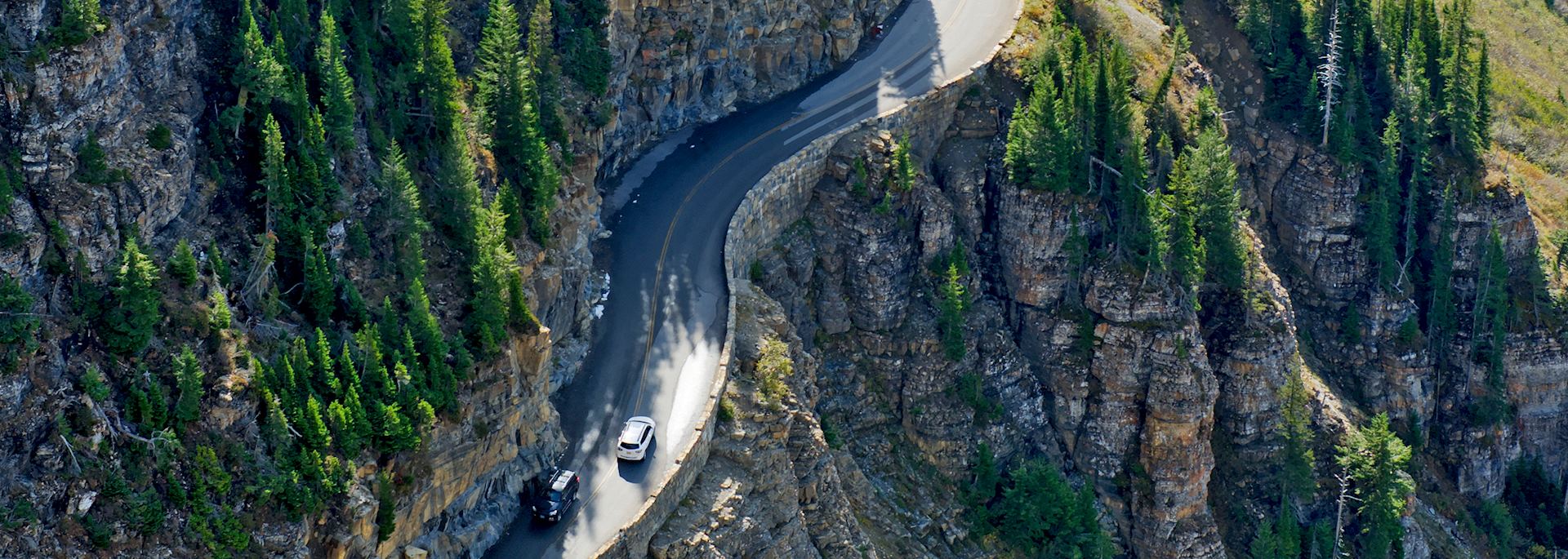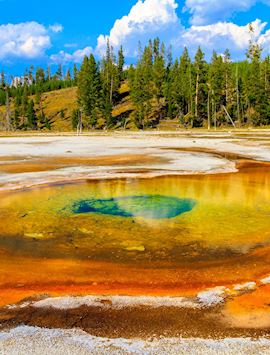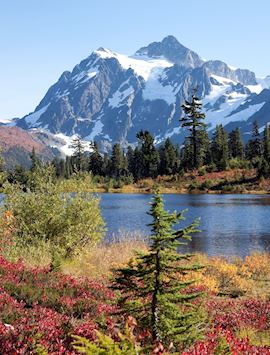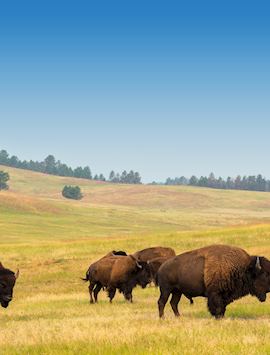By USA specialist Emma
The towering mountains, endless prairies and age-old settlements of the Rockies provide an inspirational backdrop for a road trip holiday in the USA. This is cowboy country, where saloons line the squares and traditional ranches pepper the snow-capped landscape.
My chosen car route starts in the heart of the Rockies in the small town of Jackson, just south of Yellowstone National Park, before taking you through Grand Teton National Park and into Yellowstone itself. Travel through Indian reservations to learn about Native American culture, past the emerald waters of Flathead Lake and spend some time in delightful Whitefish sampling the local huckleberry beer. Go in search of wildlife such as mountain goats and bears as you weave your way through Glacier National Park, before concluding in nearby St Marys.
Jackson Hole valley

Cowboy culture thrives in the small town of Jackson, which is sandwiched between the Teton mountain range and expansive grasslands. Log cabins and Western style buildings line the wooden boardwalks, while archways made entirely of antlers give a nod to the area's wrangler heritage.
Nestled in the Jackson Hole valley, I'd recommend spending around three nights here. The surrounding countryside is ideal for a number of outdoor pursuits, including kayaking, horse riding as well as elk, deer and black bear viewing. In town you can amble around the designer shops and art galleries.
Self-driving in Grand Teton National Park

From Jackson take the road into Grand Teton National Park. An area that epitomises the Rockies, as you drive you're sheltered by snow-capped mountain peaks to the north, the highest of which is Mount Moran, while grasslands stretch as far as the eye can see to the east.
Early settler tracks, once used by stagecoaches, criss-cross the landscape and some of the oldest settlements in the west can still be visited here. Make a stop at Mormon Row, a historic district of homesteads, where a guide can introduce you to the local history.
Wildlife viewing is also a highlight of a visit to Grand Teton National Park. There's an array of fauna here, including bison, antelope, moose, beavers, bald eagles and chipmunks, as well as bears in the foothills of the mountains.
Driving the southern loop of Yellowstone National Park

Yellowstone is a park of contrasts. You'll begin by driving on the southern loop where charred trees are a stark reminder of the power of Mother Nature. Fires are a natural part of life here and were the cause of widespread devastation in 1988, affecting 36% of the park.
Many of Yellowstone's geothermal attractions are found on the southern loop and it's worth spending a day here to explore. Visit Old Faithful geyser with its regular eruptions, and Grand Prismatic Spring — a brightly coloured hot spring with a deep blue centre ringed by turquoise and green with an outer edge that changes from yellow to orange.
The sulphurous smelling bubbling Mud Volcano, peaceful Yellowstone Lake, the roaring Yellowstone Falls and Fishing Bridge (which you can't actually fish from anymore) are just some of the other sites of interest.
I recommend spending the evening in one of the Explorer Cabins situated in West Yellowstone before embarking on a drive along the northern route of the park. While there is little to see here, the cabins are newly built and serve as a good base from which to access both loops of the park.
Driving the northern loop of Yellowstone National Park

The northern loop of Yellowstone National Park is home to a plethora of wildlife. Wolves were reintroduced here in the 1990s and are now thriving. Their presence has changed the landscape of the northern part of the park as they're a predator to the numerous elk that roam here. This has had a knock-on effect on the rest of the landscape, which has been able to recover from excessive grazing.
Wide open spaces afford views for miles, making it easy to spot the herds of bison and also bears and wolves, which wander in the distance. A tour with a private guide is one of the best ways to track the wildlife from the comfort of a vehicle kitted out with equipment such as binoculars and scopes.
Pack your swimming gear as you'll also be able to take a dip in the Boiling River, so called because of the hot springs that mix with the Gardner River, creating temperatures pleasant enough to swim in. Watch elk and bison pass by as you bathe in the temperate waters.
Driving Route 191 into Montana

From Yellowstone, head north into Montana along Route 191. The road skirts the Gallatin River and passes numerous ranches, many of which were built by early settlers, as well as Big Sky, a ski resort in the winter and a good base for outdoor activities, such as walking, in the summer.
Take the opportunity to spend some time with the cowboys, cowgirls and wranglers of these ranches who will lead you out on horse rides. Rainbow Ranch Lodge is a particular favourite of mine, the timber buildings blending seamlessly into the green landscape.
Follow the river until the countryside opens out and you meet the Interstate 90 (also known as I-90), where mountains tower over you from either side, making you feel very small in comparison.
Missoula to Flathead Lake and surrounding towns

You'll continue on the I-90 until you reach Missoula, where you'll have the choice of hot-footing it along the Helen National Forest Scenic Byway (a road recognised for its scenery, history and culture) to Flathead Lake, or taking a detour through the Flathead Indian Reservation. The reservation is home to the Confederated Salish and Kootenai tribes and I'd recommend visiting the People's Center Museum, where you can learn about local Native American history.
Flathead Lake itself is the largest freshwater lake west of the Mississippi in the mainland US. Its crystal clear, emerald waters are surrounded by vineyards and cherry orchards. There are a number of charming towns nearby, with Big Fork at the top of the lake, but Whitefish is my personal favourite. A typical mountain town that exudes charisma, Whitefish is known for its huckleberries, a deep purple, round berry farmed in the area. Visit the local brewery where you can sample a beer made from this succulent fruit.
Drive along the Going To The Sun Road

One of the final destinations on this route is Glacier National Park. You'll travel along my favourite drive in America, the Going To The Sun Road, named after a mountain of the same name.
A relatively untouched area, and lesser-visited than some of the USA's more prominent parks, Glacier is worthy of a few nights' stay. It's only accessible between late June and early September as its elevation means it's blanketed in snow for much of the year. Depending on when you travel, there may still be pockets of the park with a light dusting.
The whole area is particularly idyllic and peaceful, the setting for sapphire lakes and crashing waterfalls. You'll often see mountain goats wandering around as well as bears. On my last trip, a mother and her cub crossed the road in front of my car before tucking into some huckleberries on the side of the road.
The road through the park weaves its way up Going To The Sun Mountain, eventually travelling into the afternoon sun, hence its name. The pinnacle of this route is Logan Pass, about midway through the park. I'd heartily recommend taking in your surroundings on foot from here, the Hidden Lake walk is a particular favourite of mine. It's possible to do this walk by yourself, but I'd suggest hiring a guide who will give you a thorough introduction to the area and teach you about its history.
Base yourself either in Whitefish or at Lake McDonald Lodge on the west of the park. This property has been built in the style of old Swiss chalets and is perched on the shore of Lake McDonald itself.
Driving into St Marys and the end of the route

St Marys sits at the edge of the Blackfeet Indian Reservation on the border with Canada. Nestled in the surrounding jagged mountains and just a stone's throw away from the still, sapphire waters of the lake with the same name, St Marys is a fitting final stop on this route. Enjoy one last look at the splendour of the region before continuing on into America's northern neighbour to discover the Canadian Rockies, or returning to Jackson from where you can continue your driving tour of the US.
Practicalities of self-driving in the Rockies
- It’s possible to complete this route in three days, but I’d suggest taking your time over two or three weeks, to enjoy all the region has to offer at a relaxed pace.
- The roads around the Rockies are extremely quiet and you could be driving for an hour or so before seeing another car. The only time you’ll see a build-up of traffic is when there’s a ‘bear jam’. This is when a bear is spotted and drivers pull over to see it.
- It’s a must that you have to listen to country music in the car while driving through the Rockies (in my opinion anyway).
- I’d recommend upgrading to an SUV. These vehicles are taller and have a better view of the road and surrounding countryside.
- Most roads around the Rockies are in very good condition.
Start planning your self-drive trip in the Rockies
Start thinking about your experience. These itineraries are simply suggestions for how you could enjoy some of the same experiences as our specialists. They're just for inspiration, because your trip will be created around your particular tastes.
View All Tours in The USAFurther reading
- Self-drive holidays
- Self-drive holidays in the United States
- Route 66 holidays
- The USA’s Rockies: ranches, wolves & Wild West towns
- Self-driving the Blue Ridge Parkway
- Self-drive holidays in Florida
- Self-driving through Arizona & Utah in America’s Southwest
- Self-drive holidays in California
- Self-drive holidays in Canada





